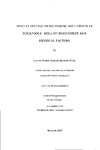SPECIES INTERACTIONS DURING SUCCESSION IN ROCKPOOLS: ROLE OF HERBIVORES AND PHYSICAL FACTORS
| dc.contributor.author | NOEL, LAURE MARIE-LOUISE JEANNE | |
| dc.contributor.other | School of Biological and Marine Sciences | en_US |
| dc.date.accessioned | 2013-11-01T10:50:27Z | |
| dc.date.available | 2013-11-01T10:50:27Z | |
| dc.date.issued | 2007 | |
| dc.identifier | NOT AVAILABLE | en_US |
| dc.identifier.uri | http://hdl.handle.net/10026.1/2515 | |
| dc.description.abstract |
Positive interactions are increasingly recognised to be important as community structure processes. Bertness and Callaway's model predicts positive interactions to be important under high consumer pressure or high environmental stress. Associational defences between organisms, when palatable algae take advantage of living with less palatable ones, will be the dominant structuring forces under high consumer pressure and low physical stress. Habitat ameliorations become more important under harsh physical conditions and low consumer pressure. This model was tested at Wembury Bay, Devon, Southwest England, using rockpools and emergent rock habitats distributed over the vertical height of the shore to generate gradients of environmental stress. Relationships between rockpool physico-chemical parameters and assemblage composition were investigated across the shore. Highest rockpool communities on the shore experienced the harshest environmental stress. Consumer pressure measured in rockpools was twice that recorded on emergent rock owing to high tide limpet movements from the surroundings into the pool rather than herbivore densities. Over these gradients, experimental plots were maintained at natural and reduced grazer density to control consumer pressure. Species interactions during succession were examined. Experimental plots distributed at three shore heights (high, mid, low) were scraped in both habitats to initiate succession and were then sampled regularly over a 2 year period. Species susceptibility to grazing drove different trajectories of succession under high and low consumer pressure suggesting that palatability influences species interactions. Physical stress affected species recruitment and development of the successional sequence in both habitats and over the intertidal gradient. Selective removal of early ephemeral and later perennial colonising algal species provided some evidence of positive interactions under both elevated levels of physical stress and high consumer pressure. These results are discussed in the context of the Bertness and Callaway model with which they are consistent and other models of succession. | en_US |
| dc.description.sponsorship | The Marine Biological Association of the UK | en_US |
| dc.language.iso | en | en_US |
| dc.publisher | University of Plymouth | en_US |
| dc.title | SPECIES INTERACTIONS DURING SUCCESSION IN ROCKPOOLS: ROLE OF HERBIVORES AND PHYSICAL FACTORS | en_US |
| dc.type | Thesis | en_US |
| plymouth.version | Full version: final and full version as approved by the examiners at the time of the award of your degree | en_US |
| dc.identifier.doi | http://dx.doi.org/10.24382/1421 |
Files in this item
This item appears in the following Collection(s)
-
01 Research Theses Main Collection
Research Theses Main


